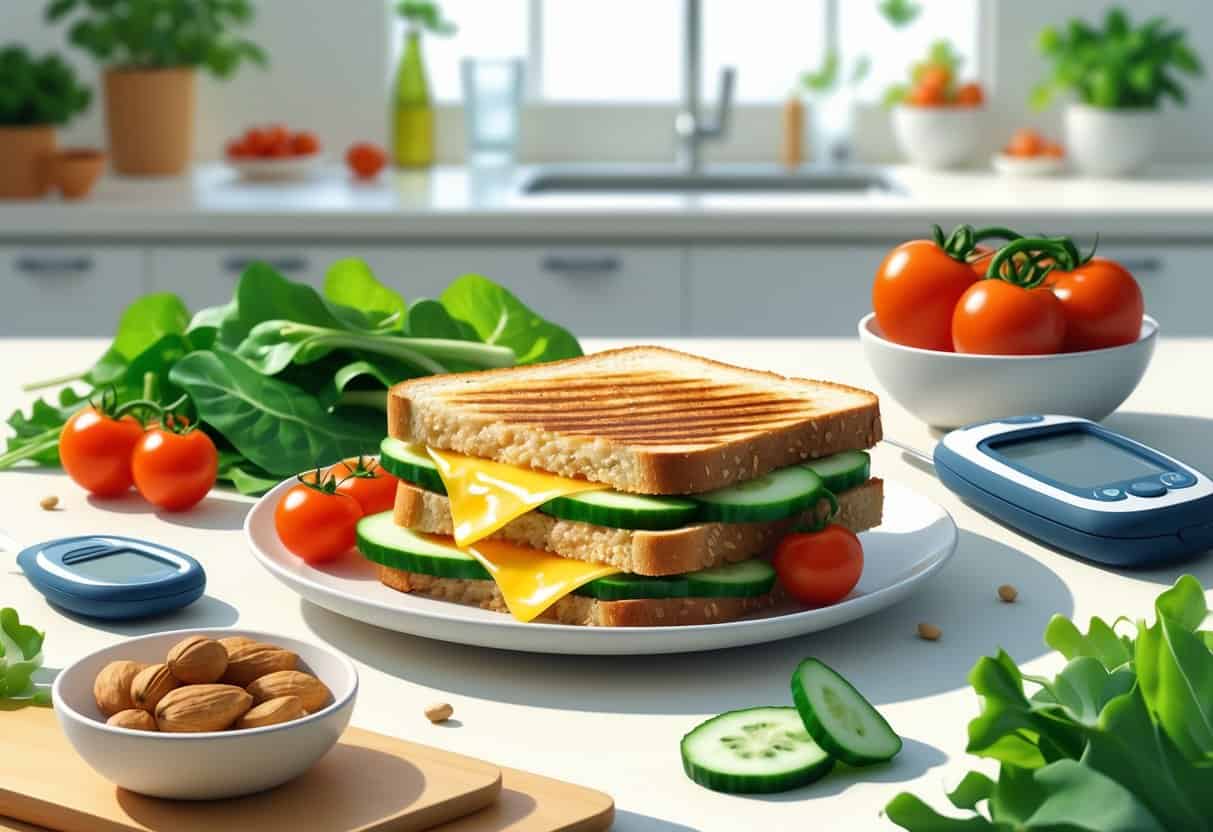If you have diabetes, you might wonder if grilled cheese sandwiches are off-limits. The truth? You can still eat grilled cheese, but you’ll need to make some smart swaps to keep your blood sugar in check.
This mostly comes down to picking the right bread, cheese, and watching your portion size.

Grilled cheese is usually made with white bread and lots of cheese—two things that can send your blood sugar soaring. But switch to whole grain bread and use a bit less cheese or a lighter cheese, and suddenly it’s a lot friendlier to your meal plan.
Key Takeaways
- Grilled cheese isn’t totally off the table if you make thoughtful ingredient choices.
- Whole grain bread and keeping portions reasonable help manage blood sugar.
- A few simple swaps can make grilled cheese work in a diabetes meal plan.
Can Diabetics Eat Grilled Cheese?
You can enjoy grilled cheese if you’re mindful about ingredients and how much you eat. It’s all about knowing how carbs, fats, and protein in your sandwich affect your blood sugar.
Impact of Grilled Cheese on Blood Sugar
The bread brings in carbs, while cheese and butter add fat. Carbs can spike your blood sugar, especially with white bread or big servings.
Switching to whole grain or low-carb bread helps lower this risk. Too much bread—healthy or not—can still cause a spike, so watch your portions.
Cutting back on butter or oil can help reduce extra fat, which also plays a role in how your body handles insulin. It’s a good idea to check your blood sugar after eating grilled cheese and see how you react. Everyone’s different, so a little trial and error isn’t a bad thing.
Role of Carbohydrates, Fats, and Protein
Bread carbs break down into sugar and raise your blood sugar. Whole grains come with fiber, which slows things down and helps keep your levels steadier.
Fats from cheese and butter don’t directly raise blood sugar, but too much saturated fat isn’t great for your heart. Picking lower-fat cheese or using less butter can help.
Protein in cheese slows digestion and can help stabilize blood sugar. Try to balance your carbs with enough protein and healthy fats. If you’re not sure what works for you, a registered dietitian can help figure out a recipe and portion size that fits your needs.
Healthy Grilled Cheese Modifications for Diabetics
Making grilled cheese more diabetes-friendly is totally doable. Focus on better bread, cheese, and maybe sneak in some veggies.
Choosing Whole Grain Bread and Healthy Oils
Start with whole grain bread instead of white. Whole grains are packed with fiber, which slows down sugar absorption and helps keep your blood sugar from spiking.
Look for bread labeled “100% whole grain” or “whole wheat.” It’s worth checking the label—sometimes brands get sneaky.
Use a bit of olive oil or avocado oil to cook your sandwich. These oils have healthier unsaturated fats, which are better for your heart. Butter and margarine tend to be higher in saturated fats, so try to go easy on them.
A light brush of olive oil gives flavor and a nice crisp without the extra saturated fat.
Low-Fat and High-Protein Cheese Options
Pick cheeses with less fat and more protein. Part-skim mozzarella or low-fat Swiss are good options.
Protein helps you feel fuller and can keep blood sugar steadier. Processed cheeses are often loaded with sodium and fat, so they’re best avoided if you can.
If you love a strong cheese, a thin slice of aged cheddar can go a long way—sometimes a little flavor is all you need.
Vegetable Additions and Diabetic-Friendly Pairings
Tossing some veggies into your grilled cheese is a simple way to add fiber and nutrients. Spinach, tomatoes, peppers, or avocado are all tasty and low in carbs.
Veggies bring fiber, which slows down how fast sugar hits your blood. That’s a win.
Pair your sandwich with a salad or some raw veggies instead of chips or fries. It keeps the meal balanced and helps your blood sugar stay steady.
Grilled Cheese and Diabetes Meal Planning
Grilled cheese can fit into your meal plan if you’re careful with what you put in it, how much you eat, and what you eat with it.
Portion Sizes and Moderation
Keep your sandwich on the smaller side. Whole grain bread is better for blood sugar, but portion size still matters.
Go easy on the cheese to cut back on fat, especially saturated fat. Skip bacon or other high-fat meats most of the time—they add extra risk for your heart.
One sandwich (or even half, if it’s big) with some low-carb sides is usually plenty.
Eating too much, even of the healthy stuff, can make blood sugar harder to manage. Moderation is key—try to tune in to your hunger and fullness cues.
Meal Timing: Breakfast, Lunch, and Dinner
Grilled cheese works for breakfast, lunch, or dinner. Timing does matter, though.
For breakfast or lunch, pair it with some protein—maybe yogurt or chickpeas—to help you stay full and avoid a sugar crash.
At dinner, skip heavy sides like potato salad. Instead, go for veggies high in potassium, like sweet potatoes or steamed greens.
Try to space your meals out during the day to avoid big swings in glucose. Maybe skip the late-night grilled cheese snack—overnight blood sugar can be tricky to manage.
Healthy Sides and Snack Ideas
Pair your grilled cheese with sides that bring in nutrients, minus the extra carbs or greasy fats. Hummus and raw veggies? Always a win for a low-carb snack, and you get some protein and fiber in the mix.
If you’re up for a bigger meal, maybe throw in some salmon or another fish for those omega-3s. Just skip the fries or anything heavy on potatoes.
For snacks, Greek yogurt works, or just grab a small handful of nuts. These little choices help keep blood sugar steady between meals.